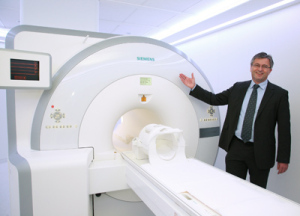by
Brendon Nafziger, DOTmed News Associate Editor | November 19, 2010

Biograph mMR,
with Bavarian State
Minister of Sciences,
Research and the Arts
Dr. Wolfgang Heubisch
At long last, PET and MR are coming together.
Siemens Healthcare will debut an integrated PET-MR device capable of doing simultaneous whole-body MRI and molecular imaging reads at the Radiological Society of North America's annual meeting in Chicago next week.
The device, the Biograph mMR, features PET detectors integrated with a 3-Tesla system. Currently, the first unit is installed at the Munich Technical University in Germany.



Ad Statistics
Times Displayed: 2640
Times Visited: 16 Fast-moving cardiac structures have a big impact on imaging. Fujifilm’s SCENARIA View premium performance CT brings solutions to address motion in Coronary CTA while delivering unique dose saving and workflow increasing benefits.
Siemens announced the device Friday at a ceremony at the university's hospital in Munich. An early version of the technology was first demonstrated
three years ago.
The hope of the investigational technology is to provide faster, more accurate cancer diagnosis and staging, as well as to further our understanding of dementia. Siemens said internal tests suggest the device can scan a patient with both imaging types in about half an hour. Normally, sequential imaging with PET and MR scans can take up to an hour, the Malvern, Pa.-based company said.
Siemens said the device got around a problem that prevented the marriage of the two modalities: PET detectors, which use photomultiplier tubes, normally can't withstand the strong magnetic fields generated by MR magnets.
Nuclear medicine specialists told DOTmed News PET-MR technology could help treatment planning for some soft-tissue tumors, such as those of the brain, liver or lung. Plus, it's expected that early clinical evidence will be presented at RSNA showing how effective MRI will be at providing attenuation correction for the PET image, a feat now generally performed by CT scanners.
But even though the device will debut next week, it's still far off from clinical use. The device still has to undergo a 510(k) review from the U.S. Food and Drug Administration.

